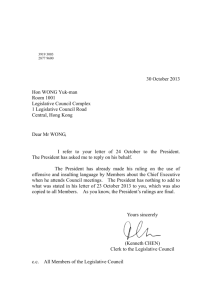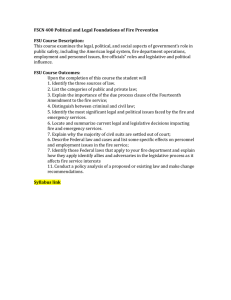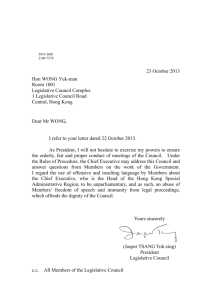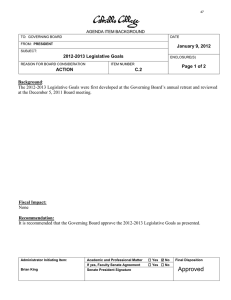Single Market Act II
advertisement
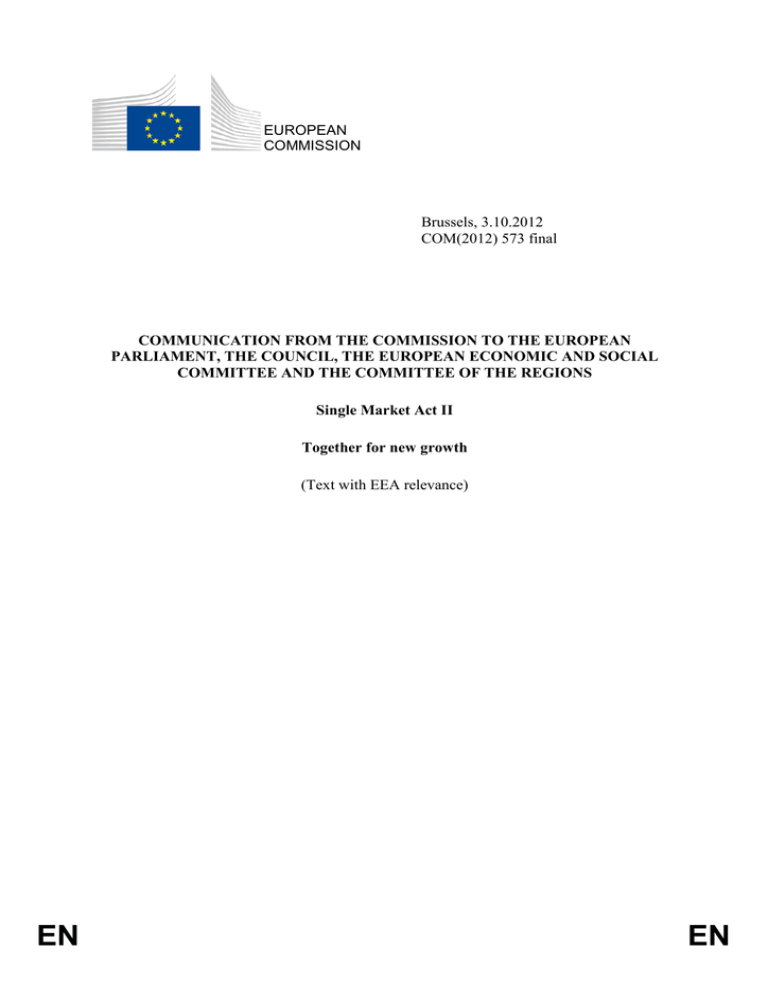
EUROPEAN COMMISSION Brussels, 3.10.2012 COM(2012) 573 final COMMUNICATION FROM THE COMMISSION TO THE EUROPEAN PARLIAMENT, THE COUNCIL, THE EUROPEAN ECONOMIC AND SOCIAL COMMITTEE AND THE COMMITTEE OF THE REGIONS Single Market Act II Together for new growth (Text with EEA relevance) EN EN COMMUNICATION FROM THE COMMISSION TO THE EUROPEAN PARLIAMENT, THE COUNCIL, THE EUROPEAN ECONOMIC AND SOCIAL COMMITTEE AND THE COMMITTEE OF THE REGIONS Single Market Act II Together for new growth (Text with EEA relevance) Table of Contents 1. INTRODUCTION....................................................................................................... 4 2. TOGETHER FOR NEW GROWTH .......................................................................... 5 2.1. Developing fully integrated networks in the Single Market ............................. 6 Rail transport ..................................................................................................... 7 Maritime transport ............................................................................................. 7 Air transport....................................................................................................... 8 Energy ............................................................................................................. 8 2.2. Fostering mobility of citizens and businesses across borders ........................... 9 Mobility of citizens............................................................................................ 9 Access to finance............................................................................................. 10 Business environment...................................................................................... 11 2.3. Supporting the digital economy across Europe ............................................... 12 Services ........................................................................................................... 13 A digital Single Market ................................................................................... 13 Electronic invoicing in public procurement .................................................... 14 2.4. Strengthening social entrepreneurship, cohesion and consumer confidence........................................................................................................ 15 Consumers ....................................................................................................... 15 Social cohesion and social entrepreneurship................................................... 16 3. CONCLUSION ......................................................................................................... 17 ANNEX I: LIST OF SMA II KEY ACTIONS ................................................................. 18 ANNEX II: SINGLE MARKET ACT I: STATUS OF ACTIONS .................................. 20 1. INTRODUCTION This year marks the 20th anniversary of the Single Market. A lot has been achieved: from 1992 to 2008 the Single Market has generated an extra 2.77 million jobs in the EU and an additional 2.13% in GDP1. For European consumers the Single Market means more choice at lower prices - a 70% reduction in mobile phone costs is but one example. For citizens, the Single Market has given them the capacity to travel freely, to settle and work where they wish. For young people it has opened up the opportunity to study abroad – more than 2.5 million students have seized this opportunity in the last 25 years. For the 23 million companies in the EU the Single Market has opened access to 500 million consumers. The message is clear, the evidence is there: a strong, deep and integrated Single Market creates growth, generates jobs and offers opportunities for European citizens which were not there 20 years ago. The development of the Single Market is a continuous exercise. The Single Market must respond to a constantly changing world where social and demographic challenges, new technology and imperatives, and pressure on natural resources and climate change must be incorporated into policy thinking. The economic and financial crisis has generated additional challenges and has emphasised the need for fundamental structural reforms. With persistent high unemployment, in particular among young people, and a part of the European population living in poverty, the economic crisis is also a social crisis. We need to address this crisis with urgency, ambition and resolve. Failure to do so would increase the risk of Europe and its Member States turning inward and could undermine the confidence in the European project. The Single Market is a key tool to achieve our long-term vision of a highly competitive social market economy. It enhances Europe's competitiveness in the global market place. Consistency and complementarity between internal and external policies will foster trade and growth. More than ever, we need a Single Market that supports reforms for more growth and jobs, strengthens the confidence of citizens and businesses and delivers concrete day-today benefits to them. It will require our continuous attention and focus. The Single Market Act2 presented by the Commission in April 2011 set out twelve levers to further develop the Single Market, reflecting the comprehensive approach that both Mario Monti and the European Parliament advocated in their respective reports on the future of the Single Market.3 4 It announced a set of twelve key actions and 50 complementary actions to boost growth and strengthen confidence. The joint involvement of the European Parliament, the EU Council, the European Economic and Social Committee, the Committee of the Regions and many stakeholders led to a widely shared political vision for the further development of the Single Market and allowed to focus political attention. However, progress is needed as a matter of urgency so that the twelve priority proposals of the first Single Market Act can be agreed rapidly and where 1 2 3 4 European Commission calculations using the macroeconomic model QUEST II. For more details on the model, please consult http://ec.europa.eu/economy_finance/publications/publication1719_en.pdf European Commission Communication: "Single Market Act. Twelve levers to boost growth and strengthen confidence. Working together to create new growth", COM(2011) 206 final. Mario Monti: "A New Strategy for the Single Market"; Report to the President of the European Commission; 9 May 2010 European Parliament: "Delivering a single market to consumers and citizens" (Grech Report); A70132/2010 4 possible by the end of this year, in line with the request by the European Council5. To date, eleven of the twelve key action proposals have not yet been agreed by the European Parliament and Council. Given the urgency of the crisis, we must act now to prepare further steps. This Communication announces therefore a "Single Market Act II" with a second set of priority actions. These actions are designed to generate real effects on the ground and make citizens and businesses confident to use the Single Market to their advantage. As the current crisis evolves and new challenges emerge, no doubt further actions will be necessary in future to power the Single Market as an engine for growth and increased welfare. The success of this endeavour will depend on whether Single Market rules are applied on the ground efficiently, in a predictable and reliable manner. To this end, the transposition and day-to-day implementation of Single Market rules by authorities in Member States is of paramount importance. The Commission will devote all its attention to this challenge as set out in the June 2012 Communication on this topic6. It calls in particular for additional efforts in sectors with the largest growth potential, i.e. services and networks. It will also improve the monitoring of the functioning of the Single Market by making use of the European semester process. The aim is to enhance peer pressure and present actions to fight remaining obstacles, at both European and national level. Importantly, for the vision of the Single Market to become a tangible reality for citizens and businesses, it will require continuous political support from all actors. The first Single Market Act already benefits from a spirit of partnership between the Commission, the European Parliament and the Council. The same spirit of partnership will be required for the delivery of the Single Market Act II. 2. TOGETHER FOR NEW GROWTH Since the adoption of the first Single Market Act in April 2011, the Commission has presented proposals for its twelve key actions and for 36 of its 50 complementary actions (see Annex II). This Communication builds upon the first Single Market Act and identifies four drivers around which to focus key actions. The four drivers for new growth put forward in this Communication are: 1. Developing fully integrated networks in the Single Market; 2. Fostering mobility of citizens and businesses across borders; 3. Supporting the digital economy across Europe; 4. Strengthening social entrepreneurship, cohesion and consumer confidence Networks are the backbone of the economy and the aim is to achieve a Single Market where citizens and businesses benefit from one single transport and energy market. The mobility of citizens and businesses across borders is at the heart of the Single Market; we must do everything to encourage it further. The digital sector is a main driver for both productivity and creativity, and we should strive for a digital Single Market where citizens and businesses are free to trade cross-border online without restrictions. Social entrepreneurship, cohesion and consumer confidence ensure inclusive growth, offering opportunities based on fair, robust and equitable rules for citizens and businesses. 5 6 European Council Conclusions; 23 October 2011; EUCO 52/11 European Commission Communication: "Better Governance for the Single Market", COM(2012) 259. 5 The twelve levers and key actions set out under these four drivers have been identified taking into account the views of the European Parliament7, Member States, the European Economic and Social Committee8 and stakeholders. They reflect better regulation principles, the work undertaken in the context of the Cost of Non-Europe Study that is being carried out on behalf of the Commission and the 20 main concerns highlighted by citizens and businesses9. Moreover, they have to be seen in conjunction with the ongoing review of Europe 2020 flagship initiatives, notably the industrial policy strategy10, the digital agenda11, the innovation union initiative12. All twelve key actions will make a contribution to growth, employment and confidence in the Single Market. They can all be delivered within the mandate of this Commission. Not all actions are legislative in nature, but they all are expected to have a real impact on the ground13. 2.1. Developing fully integrated networks in the Single Market Networks provide services which most citizens and businesses use every day, not least in the areas of transport and energy. Yet it is precisely in these two areas that the Single Market is incomplete, despite all progress made. The Commission's vision is of a Single Market for transport and energy where consumers, be they citizens or businesses, have real choice and operators are free to offer their services anywhere, anytime and to any customer on an equal basis. Efficient, integrated and sustainable transport and energy infrastructure networks are a precondition for this vision to become a reality. As well as promoting the efficient use of existing networks, the EU will continue to fund their development through its structural and cohesion funds and its trans-European networks. The proposals for the EU budget post-2013, and in particular the Connecting Europe Facility, provide important sources of investment in transport, energy and digital networks that need to be mobilised so that all Member States can fully participate in the Single Market. Considerable progress has been made towards this vision in many transport modes and with the implementation of the third energy package, leading to a better choice of services and increased consumer benefit. To contribute to the integration of the European internal transport and energy markets, the Commission will continue to pursue vigorous enforcement of the competition rules, and in particular the antitrust rules. But more must be done in particular in rail, air and maritime transport as well as in electricity and gas, as European businesses and consumers still pay unnecessarily high prices stemming from inefficient and fragmented transport and energy markets. The Commission has identified four key actions which constitute the next steps towards our common vision. The Commission will also continue to reflect on areas where additional economic, as well as environmental and social benefits could be reaped, for example in road freight. Existing cabotage restrictions contribute to a significant number of trucks 7 European Parliament Resolution of 14 June 2012 on a 'Single Market Act: The Next Steps to Growth' (2012/2663(RSP)) 8 Opinion of the European Economic and Social Committee on the Key Actions towards a Single Market Act II; CESE 1575/2012 9 European Commission: 'The Single Market through the lens of the people; http://ec.europa.eu/internal_market/strategy/docs/20concerns/publication_en.pdf 10 European Commission Communication: "An Integrated Industrial Policy for the Globalisation Era"; COM(2010)614 11 European Commission Communication: "A Digital Agenda for Europe"; COM(2010)245 12 European Commission Communication: "Innovation Union"; COM(2010)546 13 All the actions proposed to be taken up by the Commission in this document are consistent and compatible with the current MFF (2007-2013) and the proposal for the new Multiannual Financial Framework 2014-2020. 6 running empty, have a negative impact on competitiveness and trade and make it difficult to control compliance with basic social standards. Rail transport Key action 1: Open domestic rail passenger services to operators from another Member State to improve the quality and cost efficiency of rail passenger services. In the area of rail transport, operators from one Member State are still not allowed to transport passengers on domestic lines within another Member State. At the same time, public service contracts can be awarded directly without open procedures. Experience in Member States which have introduced market opening for domestic passenger services shows that competition in rail transport led to important efficiency gains, in particular in incumbent railway undertakings. This led to substantial savings in public funding for rail services under public service contracts, which could reach 20-30%. Building on these positive experiences, the Commission will table a fourth railway package. By granting all EU licenced railway undertakings the right to operate open access domestic passenger services in the EU and the right to bid for public service contracts, the package will offer more competitive and efficient domestic rail transport services of a better quality and at a lower cost for European citizens. This would attract more passengers from other transport modes with positive environmental impacts. The package will also reinforce the governance of the infrastructure management optimise the use of existing infrastructure with better allocation of capacity, planning maintenance and development works. This, together with a new common approach safety and interoperability rules, will help ensure that non-discriminatory access guaranteed so that a genuine level playing field is in place. to of to is Maritime transport Key action 2: Establish a true Single Market for maritime transport by no longer subjecting EU goods transported between EU seaports to administrative and customs formalities that apply to goods arriving from overseas ports. Approximately 40% of Single Market goods are transported via short sea shipping between EU ports14. Today, vessels travelling between EU ports are deemed to have left the EU Customs Territory. As a result, under normal procedures, ships delivering cargo from one Member State to another must still go through the same complex administrative formalities as ships arriving from overseas ports. Therefore, even though administrative simplified procedures for maritime transport have already been introduced by EU legislation, vessels travelling between EU ports still encounter a significant number of complex procedures which put intra-EU shipping at a disadvantage in comparison to other transport modes. In order to establish a true internal market for goods carried by ships, within its wider efforts to boost marine and maritime growth15, the Commission will table a "Blue Belt" package with legislative and non-legislative initiatives to reduce the administrative burden for intra-EU maritime transport to a level that is comparable to that of other 14 15 Expressed in terms of tonne/km. Estimate based on EUROSTAT data. European Commission Communication: "Blue Growth opportunities for marine and maritime sustainable growth"; COM(2012)494. 7 transport modes (air, rail, road). This will be supported by modern ICT technologies, which permit the reliable tracking of ships and cargo with a sufficient level of certainty when shipping operates within the Single Market. The attractiveness of maritime transport is dependent, moreover, on the availability, efficiency and reliability of port services. In a globalised world an integrated approach of the value chain is required. Hence, the access to ports has to be organised in an integrated way. The port authorities have a crucial role to play in this context. The availability, efficiency and reliability of port services will contribute to enhance the attractiveness of maritime transport. The Commission therefore also works on enhancing the efficiency and overall quality of port services, addressing questions of the obligations of Member States regarding the sound planning of ports and hinterland connections, transparency of public funding and port charges, and administrative simplification efforts in ports, and reviewing restrictions on the provision of services at ports. Air transport Key action 3: Accelerate the implementation of the Single European Sky to improve safety, capacity, efficiency and the environmental impact of aviation. The absence of a single integrated European airspace management has significant negative repercussions on airspace users. It results in aircraft flying unnecessary detours rather than direct routes and suffering from air traffic delays, which produces significant economic and environmental damage. The fragmentation of the European airspace causes high additional costs to airlines estimated at around €5 billion a year16. These are ultimately borne by air passengers and the European economy. Due to the continuing growth of air traffic, the existing air traffic management system is no longer sustainable for reasons of safety, capacity and cost. Accelerating the implementation of the Single European Sky through a new package of actions, including legislative actions (such as on clarifying the institutional setup, reinforcing market principles for the provision of air navigation services, accelerating SESAR deployment, redefining the performance scheme and providing the Commission with clear enforcement tools, in particular with regard to functional airspace blocks), will address the persisting barriers and will bring about large gains in performance and efficiency. It will further improve the safety of aviation in Europe, reduce transport costs for citizens and businesses and lower greenhouse gas emissions from individual flights through more direct routing. Energy Key action 4: Improve the implementation and enforcement of the third energy package and make cross-border markets that benefit consumers a reality. An integrated energy market contributes to lower energy prices and facilitates investments. It has been estimated that consumers throughout the EU could save up to € 13 billion per year if they all switched to the cheapest electricity tariff available17. An 16 Based on estimates documented in reports by the Performance Review Body of the Single European Sky and the Performance Review Commission. 17 Study on the functioning of the retail electricity markets for consumers in the EU; http://ec.europa.eu/consumers/consumer_research/market_studies/ retail_energy_market_study_en.htm 8 integrated energy market also delivers more secure energy to the EU than 27 smaller scale energy markets could and facilitates the transition towards low-carbon energy systems at the lowest possible cost. Energy must be able to flow to where it is needed, without physical barriers at national borders. Despite the adoption of the third energy package, no fully integrated European internal energy market has yet been achieved to the detriment of all energy users including private households. To achieve the agreed objective of a completed internal energy market by 2014, the rules in place should be implemented ambitiously in Member States and enforced by strong and independent national and EU authorities. Moreover, major investments in our energy systems are needed this decade to modernise the EU's networks, decarbonise systems and make them energy-efficient.18 The Commission will soon present a Communication to take stock of progress made towards the completion of the internal energy market and to propose actions that can ensure that the EU energy market fulfils its potential and satisfies the needs and expectations of EU citizens and businesses. 2.2. Fostering mobility of citizens and businesses across borders The mobility of citizens and businesses is at the heart of European integration and the Single Market. The Commission will continue to work towards its vision of a Single Market where citizens, workers and businesses are free to move cross-border whenever and wherever they want to and without unjustified restrictions imposed by divergent national rules and regulations. Mobility is a precondition for the Single Market to deliver on its potential, be it social, cultural, political or economic. The price of low mobility is high. Despite the fact that unfilled job vacancies have been rising since mid-2009, unemployment is at record levels in many Member States. At the same time, the cross-border mobility of businesses is hampered by difficulties to finance new business projects and by administrative burden. While the EU's better regulation agenda has led to an improvement of the business environment, a constant focus on the reduction of unnecessary regulatory and administrative burden must be maintained. Important next steps towards our common vision are therefore to match labour demand and supply cross-border, improve the access to finance and advance the business environment in Europe. Mobility of citizens Key action 5: Develop the EURES portal into a true European job placement and recruitment tool. The EU has taken important measures to facilitate the mobility of citizens. EU legislation allows for the export of their statutory social security rights to the Member State where they seek work. It provides for the recognition of their professional qualifications acquired in another Member State. The EURES network and its portal links national public employment services and offers information and advice on job vacancies and working conditions in other Member States. However, tools and measures to match job offers and jobseekers across Member States can be improved further to contribute to a true European labour market. To this end, the Commission will transform EURES into a more effective tool for intra-EU recruitment, 18 Europe's energy system requires investments of ca. EUR 1 trillion by 2020 of which EUR 200 billion is needed for electricity and gas networks alone; http://ec.europa.eu/energy/publications/doc/2011_energy2020_en.pdf 9 placement and job matching. Together with online instruments increasing transparency and interoperability of skills and qualifications, such as Europass and the European Qualification Framework, the availability of more services through EURES will further facilitate the cross-border mobility of workers. This will help reduce the mismatch of labour with positive effects on employment levels and economic output. The Commission will assess the possibility for EURES to also cover apprenticeships and traineeships. More should also be done to enhance mobility for third-country nationals working in the EU, notably through the swift adoption by Council and Parliament of the intra-corporate transfer (ICT) and seasonal workers proposals. The portability of supplementary social security rights, including pensions, constitutes an additional important determinant for workers' mobility between Member States. As already highlighted in the Single Market Act of April 2011, to facilitate mobility, citizens must be able to establish and keep their occupational pension rights when they move to another Member State. The Commission welcomes that the Council has agreed to recommence negotiations on the amended Commission legislative proposal from 2007 towards this aim. Access to finance Key action 6: Boost long-term investment in the real economy by facilitating access to long-term investment funds. For many companies in the EU, access to finance has become markedly more difficult with the financial crisis although a credit crunch has been averted, also due to the exceptional liquidity provision by the Eurosystem at the end of 2011. Financing conditions remain tight especially for start-ups and SMEs and in countries whose economies have been hit most severely by the crisis. A 45% drop in venture capital fundraising following the crisis is significantly limiting the funding available for innovative companies19. Smart, sustainable and inclusive growth critically depends on the availability of finance over an extended time horizon. Action has already been taken at EU level to foster longterm investment in the real economy, notably the provision of financing through EU financial instruments20 and the European Investment Bank21, the Europe 2020 Project Bond Initiative22 and the Commission action plan to improve access to finance for SMEs, combining financial and regulatory measures. As a contribution to the discussions in the European Council on growth and jobs, the Commission undertook a targeted reprogramming exercise with Member States to use structural funds for improving the access of SMEs to finance, which is also a key element for the next financing period. The Commission additionally announced a review of the impact of new bank capital 19 Report of the Chairman of the expert group on the cross border matching of innovative firms with suitable investors; European Commission 2012; http://ec.europa.eu/transparency/regexpert/ index.cfm?do=groupDetail.groupDetailDoc&id=6008&no=1 20 In particular under cohesion policy. 21 Since the beginning of the financial crisis in 2008, the European Investment Bank has provided € 40 billion of financing to more than 210,000 SMEs. European Commission Communication: "An action plan to improve access to finance for SMEs"; COM(2011)870final. 22 The aim of the Europe 2020 Project Bond Initiative is to attract institutional investors to the capital market financing of infrastructure projects. In July 2012, the EU launched a pilot phase of the EU-EIB Project Bond Initiative. 10 requirements resulting from the implementation of the new Basel III standards in certain key areas, such as SME financing. However, this type of 'long-term investment' in the real economy remains constrained. Concrete policy options to address this issue will be assessed in the context of the forthcoming Green Paper on financing long-term investment in the EU economy. In addition, the Commission will make proposals on possible forms of long-term investment funds. Investment funds can open new sources of financing to long term projects and private companies. They can constitute an attractive offer to retail investors who seek to invest long-term, diversify risk and prefer stable and steady returns with lower volatility, as long as the necessary degree of investor protection is ensured. Venture capital is a vital complement to bank financing when it comes to providing financing to small companies with growth potential. Under the SMA I, the Commission proposed a Regulation to facilitate the raising of capital and its investment cross-border by venture capital funds. To this end, in 2012 the Commission will complete its examination of possible tax obstacles to cross-border venture capital investment, on the basis of which it will consider next steps with a view to presenting solutions in 2013, while at the same time preventing tax avoidance and evasion.23 Business environment Key action 7: Modernise EU insolvency rules to facilitate the survival of businesses and present a second chance for entrepreneurs. Businesses operating in Europe benefit from an overall positive business environment, which the EU is further improving through its better regulation agenda. But more can be done. Europe needs modern insolvency laws that help basically sound companies to survive, encourage entrepreneurs to take reasonable risks and permit creditors to lend on more favourable terms. A modern insolvency law allows entrepreneurs to get a second chance and ensures speedy procedures of high quality in the interest of both debtors and creditors. We thus need to establish conditions for the EU wide recognition of national insolvency and debt-discharge schemes, which enable financially distressed enterprises to become again competitive participants in the economy. We need to ensure simple and efficient insolvency proceedings, whenever there are assets or debts in several Member States. Rules are needed for the insolvency of groups of companies that maximise their chances of survival. To this end, the Commission will table a legislative proposal modernising the European Insolvency Regulation. However, we need to go further. At present, there is in many Member States little tolerance for failure and current rules do not allow honest innovators to fail 'quickly and cheaply'. We need to set up the route towards measures and incentives for Member States to take away the stigma of failure associated with insolvency and to reduce overly long debt discharge periods. We also need to consider how the efficiency of national insolvency laws can be further improved with a view to creating a level playing field for companies, entrepreneurs and private persons within the internal market. To this end, the Commission will table a Communication together with the revision of the European Insolvency Regulation. 23 The Commission has launched a public consultation. http://ec.europa.eu/taxation_customs/common/consultations/tax/2012_venture_capital_en.htm 11 See: Additional actions are needed to further improve the business environment. Diverging national tax systems cause considerable administrative burden to companies operating across EU borders. The fact that each Member State applies different VAT rules and procedures causes particular problems24, not least for SMEs that wish to operate in another Member State. The Commission has therefore announced that it will propose to introduce standard VAT declarations to allow businesses on an optional basis to complete a standard VAT declaration rather than a different VAT form in every Member State.25 Economic growth is increasingly driven by investments in intangible assets, such as R&D, patents and know-how. This requires improving the business environment to make sure it efficiently promotes and protects creativity and innovation. Further to the agreement reached at the June European Council, the adoption of legislation on unitary patent protection in the EU accompanied by a single specialised jurisdiction, a key action under the Single Market Act of April 2011, would be a fundamental step in that direction. It should allow the first registration of unitary effect of a European patent by spring 2014, reducing the costs of patenting across the European Union and those associated to patent litigation. In order to encourage investment in intangible assets on the one hand, and to help innovative companies turn their R&D efforts into competitive gains on the other, the Commission services will examine the issue of valuation methods for intellectual property and will consider addressing the very fragmented legal framework for trade secret protection with a view to making it safer and less costly for business and research bodies to license, transfer and share valuable knowledge and information throughout the internal market. 2.3. Supporting the digital economy across Europe The digital economy is changing the Single Market profoundly. With its innovation, speed and reach across borders it has the potential to take Single Market integration to a new level. The Commission's vision is a digital economy that delivers sustainable economic and social benefits based on modern online services and fast internet connections. All citizens and businesses must have the opportunity to be part of the digital economy, while at the same time being protected from illicit trade. In some key economies, the internet economy already accounted for 21% of GDP growth in the period 2006-201126. The digital economy has strong additional spill-over effects, improving productivity and providing new solutions to societal challenges like demographic ageing, inclusion and education. Additional efforts are needed to achieve quickly the objectives set in the Digital Agenda for Europe27 and the Communication on e-Commerce and Online Services28. Progress in tackling the fragmentation of online services along national borders, addressing the highspeed network investment challenge and reaping the benefits of paperless public administration are important next steps. 24 European Commission Communication: "Action Programme for Reducing Administrative Burdens in the EU Sectoral Reduction Plans and 2009 Actions", COM(2009) 544, and: http://ec.europa.eu/enterprise/policies/better-regulation/documents/ab_studies_2009_en.htm. 25 European Commission Communication: "On the future of VAT"; COM(2011)851 26 McKinsey Global Institute, "Internet matters, the net's sweeping impact on growth, jobs and prosperity", May 2011. 27 European Commission Communication: "A Digital Agenda for Europe", COM(2010) 245 final. 28 European Commission Communication: "A coherent framework for building trust in the Digital Single Market for e-commerce and online services", COM(2011) 942. 12 Services Key action 8: Support online services by making payment services in the EU more efficient. Within the services sector, online services offer particular opportunities. Realising these gains will require the right framework conditions, particularly cross-border. As already highlighted in the Single Market Act of April 2011, payment services and delivery services for goods ordered online require particular attention. With 35% of internet users not buying online because they have doubts over payment methods and with remaining barriers to market entry29, the improvement of the payments market is a first priority. A number of issues need to be addressed, such as insufficient harmonisation, ineffective competition in some areas of the card and internet payments and lack of incentives for technical standardisation, for example in the area of mobile payments. The Commission will therefore propose a revision of the Payment Services Directive. It will also make a legislative proposal on multi-lateral interchange fees for card payments. Efficient, reliable and affordable parcel delivery services for goods ordered online constitutes an additional priority and the Commission will take decisions on next steps in 2013, following a public consultation. As announced in the Single Market Act of April 2011, to reap the growth potential of the Services Directive by 2015 the Commission presented an action plan in June this year30. Member States and the Commission must work together to implement its actions immediately, as called for by the European Council. They should give particular attention to full compliance with the Services Directive and maximising its economic effect, the planned Charter for fully electronic Points of Single Contact and the mutual evaluation of rules governing regulated professions. They should also ensure the full application of the 'non-discrimination' clause of the Services Directive, whereby service providers may not differentiate between their customers on the basis of their nationality or place of residence unless objectively justified. In the context of its forthcoming European Retail Action Plan, the Commission will step up its work to identify and combat unfair trading practices, in line with its commitment in the Single Market Act in April 2011. Such practices are particularly detrimental to SMEs. In the absence of satisfactory progress to eliminate unfair trading practices, including in the context of the High Level Forum for a Better Functioning Food Supply Chain, the Commission will consider appropriate next steps in 2013. A digital Single Market Key action 9: Reduce the cost and increase efficiency in the deployment of high speed communication infrastructure. Access to high-speed broadband is a crucial factor for innovation, competitiveness and employment. A 10% increase in broadband penetration can result in a 1-1.5% increase in GDP annually31 and 1.5% labour productivity gains32. Broadband-induced innovation in 29 Eurostat Community Survey on ICT usage by Households and Individuals (2009). Full application by all Member States would generate economic growth of 2.6% of EU GDP. European Commission Communication: "A partnership for new growth in services 2012-2015", COM(2012) 261. The Commission will report on progress with the implementation of the Services Directive in the context of its 2013 Annual Growth Survey. 31 Czernich, N., Falck, O., Kretschmer, T., and Woessman, L. (2009) Broadband infrastructure and economic growth (CESinfo Working Paper no. 2861 30 13 companies creates employment and has the potential to generate 2 million extra jobs by 202033. Yet despite progress made, the EU is still suffering from underinvestment in the deployment of high-speed broadband networks across the Single Market and is far from achieving the Digital Agenda high-speed Internet targets34. The Single Market can help to accelerate progress substantially by addressing a key underlying cause of this investment 'latency', i.e. unnecessarily high civil engineering costs which can make up to 80% of total costs in this field and could be reduced by up to one quarter simply by cross-utility re-use of existing infrastructure35. The Commission will propose common rules which would enable operators to exploit fully the cost-reduction potential in employing broadband. The rapid adoption by the European Parliament and the Council of the Commission proposal for a Connecting Europe Facility would help the efficient roll-out of high-speed broadband and digital service infrastructures by using the EU budget efficiently to leverage private investment in a key sector of the economy. To reach our vision of the digital Single Market, the EU must address swiftly a number of further issues, including the best use of spectrum in the Single Market and pursuing a reflection on the need to further adapt the EU telecommunications law and copyright law. The Commission plans to take the latter issue forward, starting with the follow-up to the Green Paper on the online distribution of audiovisual works and the rapid conclusion of the review of the 2001 Copyright Directive. Electronic invoicing in public procurement Key action 10: Make electronic invoicing the standard invoicing mode for public procurement. A shift towards paperless public administration, particularly in its cross-border dimension, should be a mid-term objective for the European Union and Member States. The Digital Agenda for Europe36 includes a call to increase the use of eGovernment services by 50% of EU citizens and 80% of EU businesses by 2015. A particularly promising area is e-invoicing, which the Commission has called for to become the predominant invoicing mode in the EU by 2020 37. The introduction of legislative measures making e-invoicing a standard practice in public procurement will make the public sector a 'lead market' for e-invoicing and spearhead its wider use in the economy. Action in this area will make post-award procedures in public procurement more efficient and cheaper for the parties involved as well as for the taxpayer. It will also contribute to reducing delays in payments from public administrations. In the case of the public sector, a preliminary estimate indicates that in 32 Booz & Company (2012) Maximising the impact of Digitalisation http://www.booz.com/media/uploads/BoozCo_Maximizing-the-Impact-of-Digitization.pdf 33 Commission estimate based on national studies (Liebenau, J., Atkinson, R., Karrberg, P., Castro, D. and Ezell, S., 2009, The UK Digital Road to Recovery; Katz R.L. et al , 2009, The Impact of Broadband on Jobs and the German Economy) 34 European Commission Communication: "A Digital Agenda for Europe", COM(2010) 245. 35 Analysys Mason (2008), The costs of deploying fibre-based next-generation broadband infrastructuret 36 European Commission Communication: "A Digital Agenda for Europe", COM(2010) 245. 37 European Commission Communication: "Reaping the benefits of e-invoicing for Europe", COM(2010)712 14 the next few years, savings of approximately €1 billion per year could potentially be achieved if all invoices were submitted in electronic format38. In addition, action is necessary to avoid the further fragmentation of the Single Market, due to the on-going establishment of national e-invoicing systems operating on the basis of different, often national, standards. This increases complexity and costs for firms entering into cross-border contracts with public authorities across the EU. The Commission will therefore propose concrete actions to achieve these objectives in 2013. The transition towards e-invoicing in public procurement will complement the on-going modernisation of EU public procurement rules39, a key action under the Single Market Act of April 2011. Public authorities that already rely on electronic means for procuring goods, services and works report savings between 5% and 20%. Rolling out eprocurement EU-wide could save public budgets in the EU at least 100 billion Euro annually40. With this in mind, the Commission proposed the full transition to pre-award e-procurement by mid-201641. Council and Parliament should adopt the proposal without delay. 2.4. Strengthening social entrepreneurship, cohesion and consumer confidence With the economic crisis hitting the most vulnerable parts of our societies and territories hardest, it is the vision of the Commission that Single Market policies deliver inclusive growth without discrimination, allow for economic and social participation and spur territorial cohesion. The average unemployment rate in the EU stood at 10.4% in July 201242 and approximately 81 million European citizens are at risk of poverty43, highlighting the urgency to act. Single Market policies must help address the roots of exclusion in our societies. The social economy and social enterprises are key actors delivering social innovation, inclusiveness and trust. Harnessing confidence in the Single Market and strengthening the social market economy demands highly responsible and innovative companies which can make a positive impact on society and the environment. Confidence is also important for consumers to make full use of the Single Market and feel safe to consume goods and services they purchase domestically or from another Member State. Consumers Key action 11: Improve the safety of products circulating in the EU through better coherence and enforcement of product safety and market surveillance rules. The EU has a fast, efficient and reliable network in place to ensure compliance with safety rules. However, the coherence and enforcement of the existing mechanisms can be improved further. In a Single Market in which products circulate freely across 27 national territories, market surveillance needs to be highly coordinated to permit quick intervention across a large area. Market surveillance should enable unsafe or otherwise 38 This figure is based on the Commission's own estimates based on publicly available data. The actual impact of a Commission initiative in this area might differ from this figure. 39 Proposal for a Directive of the European Parliament and of the Council on public procurement, COM/2011/896 final, and Proposal for a Directive of the European Parliament and of the Council on procurement by entities operating in the water, energy, transport and postal services sectors, COM(2011) 895 final, a key action of the Single Market Act I. 40 European Commission Communication: "A strategy for e-procurement" COM(2012)179 final 41 European Commission Communication: "A strategy for e-procurement" COM(2012)179 final 42 Eurostat 43 Eurostat EU-SILC, reference year 2010 15 harmful products to be identified and kept or taken off the market and dishonest and criminal operators to be punished. It should also act as a powerful deterrent. The Commission will propose a package of legislative and non-legislative measures that will provide consumers with a more homogenous Single Market for safe and compliant products and better protection of health, safety and the environment. It will equally lower compliance costs for businesses and help eliminate unfair competition from rogue operators, in particular through better coordination of product safety checks at the EU external border. Also, consumers demand an increasing amount of information on the goods they purchase. Transparency and comparability of information are key to permitting consumers to make intelligent choices. As announced in the Single Market Act of April 2011, the Commission will propose a methodology to calculate the environmental (including greenhouse gas emissions) impact of products and how this could be presented to consumers. Social cohesion and social entrepreneurship Key action 12: Give all EU citizens access to a basic payment account, ensure bank account fees are transparent and comparable, and make switching bank accounts easier. Access to payment accounts and other banking services have become essential for participation in economic and social life, but discrimination, for instance on grounds of residence, nationality or low level of resources, does still occur. Thanks to the range of services attached to it, a payment account plays an important role in the integration of citizens into the wider social and economic community. There is therefore a need to assist citizens who may experience difficulties in opening a bank account to facilitate social and territorial cohesion and mobility. Further, evidence of persistent problems regarding the clarity of bank fee information makes it difficult for EU citizens to make informed choices. As a result, consumers tend to refrain from switching accounts as offers are difficult to compare. The Commission will make legislative proposals to address these issues. In its Social Business Initiative of October 201144 the Commission set out an action plan to strengthen the role of social businesses in the Single Market, as announced in the Single Market Act of April 2011. The action plan is currently being implemented in close connection with the expert group on social business and relevant stakeholders. In early 2014 the Commission will take stock of progress made and discuss what more needs to be done to promote social entrepreneurship. The Commission launched the Diogo Vasconcelos Social Innovation Prize on 1 October 2012. In the area of social entrepreneurship, the most pressing issue at present is to develop tools to enhance trust in, and visibility of, social enterprises. New tools need to be agreed to demonstrate to consumers, bankers, investors and public authorities the positive returns of social enterprises. The Commission will develop a methodology to measure the socio-economic benefits created by social enterprises. The development of rigorous and systematic measurements of social enterprises' impact on the community, while not smothering them in red-tape, is essential to demonstrate that the money invested in social enterprises yields high savings and income (e.g. taxes or jobs created). Methodologies to measure social impacts will, among others, be required for the implementation of the European Social Entrepreneurship Funds proposal or for the financial instrument on 44 European Commission Communication: "Social Business Initiative", COM(2011) 682. 16 social entrepreneurship support under the Programme for Social Change and Innovation, currently being negotiated by the European Parliament and Council. Given that a proactive involvement of workers in their companies has a strong impact on their societal responsibility and productivity, the Commission will also focus its attention on the issue of co-operatives and employee share-ownership. Finally, disability, including disability associated with ageing, should not prevent individuals and groups from benefiting from the Single Market. The Commission is currently working on an initiative to enhance the access of people with disabilities to goods and services within the Single Market. 3. CONCLUSION The Single Market Act II sets out twelve immediate priorities, which the Commission will focus on to support growth, employment and confidence in the Single Market. They constitute the next steps towards our vision of a highly competitive social market economy. We need to act jointly, in particular among the European institutions and with Member States, to put them into practice as soon as possible. The Commission commits to deliver all key legislative proposals by spring 2013 and all key non-legislative actions by the end of that year at the latest. The Commission calls on the European Parliament and the Council to fast-track all key legislative actions and adopt them as a priority by spring 2014. If implemented swiftly, the Single Market Act II, together with the delivery of the Single Market Act I, will open new paths towards growth, employment and social cohesion for 500 million Europeans. It will show the determination of Europe to create new growth through a common agenda to exit the crisis. Together we need to act quickly and with ambition. We have no time to lose. 17 ANNEX I: LIST OF SMA II KEY ACTIONS Lever Key Action Proposal by Commission the Developing fully integrated networks in the Single Market 1 Rail transport Adopt a fourth railway package to Legislative proposal to improve the quality and cost efficiency be presented in Q4 2012 of rail passenger services 2 Maritime transport Adopt the "Blue Belt" package to Package of legislative non-legislative establish a true Single Market for and measures to be maritime transport presented in Q2 2013 3 Air transport plan with Accelerate the implementation of the Action Single European Sky through a new legislative measures to be presented in Q2 package of actions 2013 4 Energy Implement an action plan to improve Action plan to be the implementation and enforcement presented in Q4 2012 of the third energy package Fostering mobility of citizens and businesses across borders 5 Mobility of citizens Develop the EURES portal into a true Legislative Decision to European placement and recruitment be taken by the Commission in Q4 tool 2012 6 Access to finance Boost long-term investment in the real Legislative proposal to economy by facilitating access to be presented in Q2 2013 long-term investment funds 7 Business environment Modernise EU insolvency rules to facilitate the survival of businesses and present a second chance for entrepreneurs Legislative proposal and Communication to be presented in Q4 2012 Supporting the digital economy across Europe 8 Services Revise the Payment Services Directive Legislative proposal to and make a proposal for multilateral be presented in Q2 interchange fees to make payment 2013 services in the EU more efficient 9 Digital Single Market Adopt common rules to reduce cost Legislative proposal to and increase efficiency in the be presented in Q1 2013 deployment of high speed broadband 18 10 Public procurement & electronic invoicing Adopt legislation making electronic Legislative proposal to invoicing the standard invoicing mode be presented in Q2 2013 for public procurement Strengthening social entrepreneurship, cohesion and consumer confidence 11 Consumers 12 Social cohesion Adopt a legislative initiative to give all Legislative proposal to and social EU citizens access to a basic payment be presented in Q4 entrepreneurship account, ensure bank account fees are 2012 transparent and comparable and make switching bank accounts easier Improve the safety of products circulating in the EU through a revised General Product Safety Directive, a new single Regulation on Market Surveillance and a flanking action plan 19 Package of legislative and non-legislative measures to be presented in Q4 2012 ANNEX II: SINGLE MARKET ACT I: STATUS OF ACTIONS Lever Action Deliverable OR Result / Status Access to finance for SMEs KEY ACTION Introduce legislation on venture capital funds Adopt Action Plan on SMEs Access to Finance European Commission presented legislative proposal on 7 December 2011. Revise Transparency Directive European Commission presented legislative proposal on 25 October 2011. Revise Regulation implementing Prospectus Directive European Commission presented legislative proposal on 30 March 2012. Revise Market Abuse Directive European Commission presented legislative proposal on 20 October 2011. Revise MiFID Directive European Commission presented legislative proposal on 20 October 2011. Mobility citizens for KEY ACTION Revise system for the recognition of professional qualifications Publish White Paper on Pensions Adopt legislation on complementary pension rights (portability) Revise IORPs Directive Intellectual property rights European Commission adopted Action Plan on 7 December 2011. European Commission presented legislative proposal on 19 December 2011. European Commission published White Paper on 16 February 2012. European Commission presented legislative proposal on 9 October 2007. European Commission preparing legislative proposal. Create European Skills Passport European Commission preparing Passport. Adopt Council Recommendation on non-formal and informal learning European Commission presented proposal for a Council Recommendation on 5 September 2012. European Commission presented KEY ACTION Adopt legislation setting up legislative proposals on 13 April 2011. unitary patent protection 20 Consumers Explore the development IPR valorisation instrument European Commission exploring options for the development of such an instrument Adopt legislation on collective rights management European Commission presented legislative proposal on 11 July 2012. Adopt legislation on orphan works European Commission presented legislative proposal on 24 May 2011. Enhance role of Observatory on Counterfeiting and Piracy Regulation adopted by the European Parliament and Council on 19 April 2012, following a Commission legislative proposal presented on 24 May 2011. Combat piracy and counterfeiting more effectively European Commission carrying out consultations on next steps. Present a legislative proposal to amend the existing customs regulation European Commission presented legislative proposal on 24 May 2011. Modernise the European trademark system European Commission preparing legislative proposal. KEY ACTION Adopt legislations on alternative dispute resolution / online dispute resolution Pursue work on European approach to collective redress European Commission presented legislative proposal on 29 November 2011. European Commission considering policy options. Revise General Product Safety European Commission Directive legislative proposal. preparing Draw up Action Plan on Market European Commission preparing Action Surveillance Plan. Propose initiative environmental footprint products Publish Communication Passenger Rights on European of initiative Commission preparing on European Commission adopted Communication on 19 December 2011. 21 Review of Directive on Package European Commission Travel legislative proposal. preparing Ensure transparency of bank fees European Commission preparing legislative proposal. Present legislation to protect European Commission presented borrowers in mortgage markets legislative proposal on 31 March 2011. Services Networks KEY ACTION Revise legislation on European standardisation system Ensure implementation of Services Directive Carry out performance check to test joint application on the ground of Community legislation as implemented and applied by MS in key sectors (construction, tourism, business services) Launch initiative to combat unfair trading practices Set up High-level Group on Business Services European Commission presented legislative proposal on 1 June 2011. European Commission adopted Communication on 8 June 2012. European Commission adopted Communication on 8 June 2012. European Commission preparing Communication. European Commission preparing set-up of High-level Group European Commission presented KEY ACTION Adopt energy and transport legislative proposals on 19 October 2011. infrastructure legislation to roll out strategic projects Adopt Decision establishing radio A Decision was adopted by the European Parliament and Council on 15 February spectrum policy programme 2012, following a Commission legislative proposal presented on 20 September 2010. Digital Single KEY ACTION Market Adopt legislation on eSignature, eIdentification, eAuthentification Present proposals on roaming tariffs Present action plan development of eCommerce European Commission presented legislative proposal on 4 June 2012. A Regulation was adopted by the European Parliament and Council on 30 May 2012 following a Commission legislative proposal presented on 6 July 2011. for European Commission adopted Action Plan on 11 January 2012. 22 Social entrepreneurship Present guidance to Member States on identifying unjustified consumer discrimination on basis of nationality / country of residence Revise Directive on Public Sector Information European Commission presented Staff Working Document as part of services package on 8 June 2012. KEY ACTION Adopt legislation facilitating development of social investment funds Introduce legislation establishing European Foundation Statute European Commission presented legislative proposal on 7 December 2011. European Commission presented legislative proposal on 12 December 2011. European Commission presented legislative proposal on 8 February 2012. Launch a Social Business European Commission launched initiative Initiative on 25 October 2011 Commission adopted Adopt a Communication on CSR European Communication on 25 October 2011. Legislative proposal on non- European Commission financial reporting by companies legislative proposal. Taxation KEY ACTION Review Energy Tax Directive Introduce CCCTB Identify elements of VAT Strategy Resolve cross-border taxation problems for citizens Social cohesion preparing European Commission presented legislative proposal on 13 April 2011. European Commission presented legislative proposal on 16 March 2011. European Commission adopted Communication on 6 December 2011. European Commission adopted Communication on ways to address double-taxation on 11 November 2011 and a Communication and Recommendation on inheritance taxation on 15 December 2011. European Commission presented legislative proposals on 21 March 2012, but subsequently withdrew the proposal on clarifying the exercise of freedom of establishment/services alongside fundamental social rights. KEY ACTION Introduce legislation on implementation of Posting of Workers Directive and on clarifying exercise of freedom of establishment/services alongside fundamental social rights Commission adopted Present Communication on SGEIs European Communication on 20 December 2011. European Commission legislative Decision adopted on 20 December 2011. Revise post-Altmark package 23 Present initiative on access to European Commission adopted basic payment account Recommendation on 18 July 2011. Business environment KEY ACTION Adopt legislation simplifying Accounting Directives Adopt Directive to simplify the financial reporting obligations of specifically micro-entities European Commission presented legislative proposal on 25 October 2011. Introduce optional European contract law instrument Adopt Regulation to simplify cross-border recovery of debt European Commission presented legislative proposal on 11 October 2011. European Commission presented legislative proposal on 20 July 2011. KEY ACTION Revise Procurement Directives European Commission presented legislative proposal on 20 December 2011. A Directive was adopted by the European Parliament and Council on 14 March 2012 following a Commission legislative proposal presented on 26 February 2009. Adopt European Private Company European Commission presented Statute legislative proposal on 25 June 2008. Public Procurement Introduce (amending) directive on European Commission presented the award of concession contracts legislative proposal on 20 October 2011. Introduce legislation on European Commission presented procurement with third countries legislative proposal on 21 March 2012. 24

